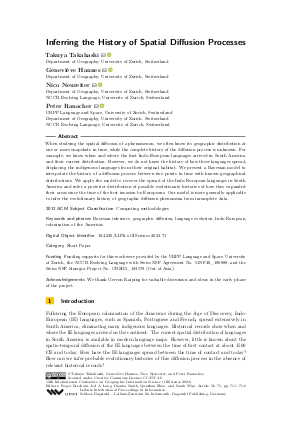@InProceedings{takahashi_et_al:LIPIcs.GIScience.2023.71,
author = {Takahashi, Takuya and Hannes, Genevi\`{e}ve and Neureiter, Nico and Ranacher, Peter},
title = {{Inferring the History of Spatial Diffusion Processes}},
booktitle = {12th International Conference on Geographic Information Science (GIScience 2023)},
pages = {71:1--71:6},
series = {Leibniz International Proceedings in Informatics (LIPIcs)},
ISBN = {978-3-95977-288-4},
ISSN = {1868-8969},
year = {2023},
volume = {277},
editor = {Beecham, Roger and Long, Jed A. and Smith, Dianna and Zhao, Qunshan and Wise, Sarah},
publisher = {Schloss Dagstuhl -- Leibniz-Zentrum f{\"u}r Informatik},
address = {Dagstuhl, Germany},
URL = {https://drops-dev.dagstuhl.de/entities/document/10.4230/LIPIcs.GIScience.2023.71},
URN = {urn:nbn:de:0030-drops-189662},
doi = {10.4230/LIPIcs.GIScience.2023.71},
annote = {Keywords: Bayesian inference, geographic diffusion, language evolution, Indo-European, colonisation of the Americas}
}

 Creative Commons Attribution 4.0 International license
Creative Commons Attribution 4.0 International license

